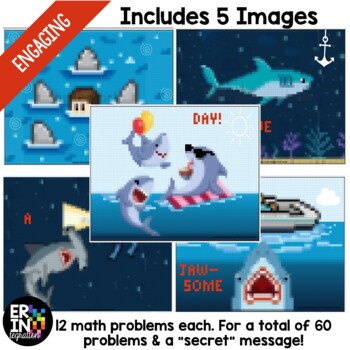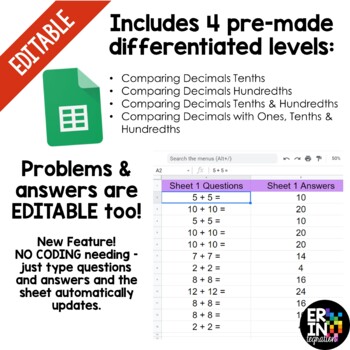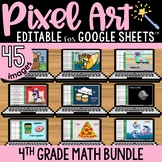Ordering and Comparing Decimals Pixel Art Math | 5 Images | Google Sheets
- PDF
- Google Apps™
- Excel Spreadsheets

What educators are saying
Also included in
- 4th grade pixel art math bundle! Practice fourth grade math skills to AUTO-GENERATE one of 5 pixel art images in Google™ Sheets (or Microsoft Excel™) plus a "secret message" in each set.That's a total of 540 self-checking math problems!★ Skills Practiced:• Adding Fractions to Complete the Whole• OrdPrice $35.93Original Price $44.91Save $8.98
Description
Comparing decimals mystery pixel art math featuring a shark theme! Have students practice place value by comparing decimals with the < and > signs to AUTO-GENERATE one of 5 pixel art images in Google™ Sheets (or Microsoft Excel™) plus a "secret message."
★ Low Prep: Just assign the sheet in Google Classroom. Each sheet includes all 5 images; students click the tabs at the bottom to advance to the next pixel image. There are 12 math problems per image to solve.
★ Differentiated: Includes 4 levels - choose 1 to assign:
- Comparing Decimals Tenths
- Comparing Decimals Hundredths
- Comparing Decimals Tenths & Hundredths
- Comparing Decimals with Ones, Tenths & Hundredths
★ Editable: The sheet can be easily edited - just change the problems and answers on the Answer Key sheet - no coding needed!
★ Self-checking: As students solve the problems in Column A, by typing their answers in Column B, a mystery pixel art image is revealed, piece by piece. Students will know they have typed the correct answer if they see pixels appearing!
You and your students will need Google Drive accounts or access to Microsoft Excel.
~~~~~~~~~~~~~~~~~~~
This SAME set of images is available to purchase in 5 versions:
- Friends of Ten
- Expanded Form
- Rounding to Nearest 10 and 100
- Comparing Decimals
- Order of Operation (No Exponents)
~~~~~~~~~~~~~~~~~~~
MORE DIGITAL MAGIC REVEAL PIXEL ART
~~~~~~~~~~~~~~~~~~~
Google and Google Apps are trademarks of Google Inc. © 2015 Google Inc. All rights reserved. Microsoft Excel is a trademark of Microsoft. Erintegration is not affiliated with and has not been authorized, sponsored, or otherwise approved by Google Inc. or Microsoft. By purchasing this resource, you agree not to create derivative resources for commercial sale or for free distribution beyond a single classroom using the formulas and pixel art images provided by Erintegration.






